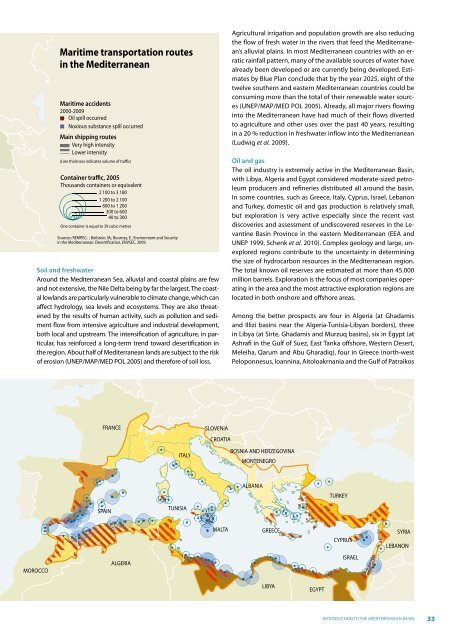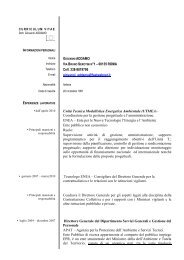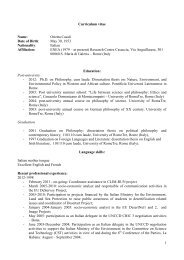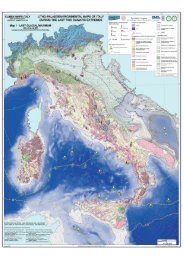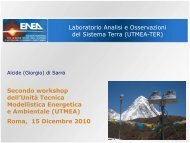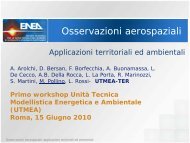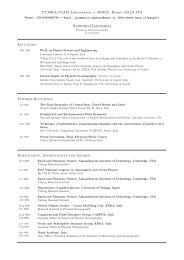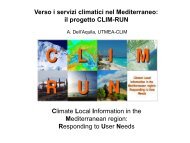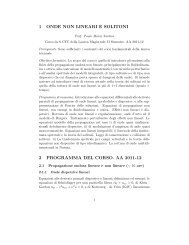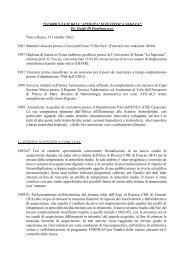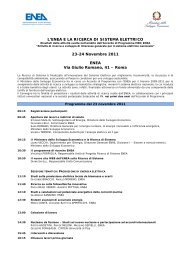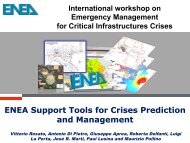State of the Mediterranean Marine and Coastal Environment
State of the Mediterranean Marine and Coastal Environment
State of the Mediterranean Marine and Coastal Environment
You also want an ePaper? Increase the reach of your titles
YUMPU automatically turns print PDFs into web optimized ePapers that Google loves.
Maritime transportation routes<br />
in <strong>the</strong> <strong>Mediterranean</strong><br />
Maritime accidents<br />
2000-2009<br />
Oil spill occurred<br />
Noxious substance spill occurred<br />
Main shipping routes<br />
Very high intensity<br />
Lower intensity<br />
(Line thickness indicates volume <strong>of</strong> traffic)<br />
Container traffic, 2005<br />
Thous<strong>and</strong>s containers or equivalent<br />
2 100 to 3 180<br />
1 200 to 2 100<br />
600 to 1 200<br />
300 to 600<br />
40 to 300<br />
One container is equal to 39 cubic metres<br />
Sources: REMPEC; ; Beilstein, M;, Bournay, E., <strong>Environment</strong> <strong>and</strong> Security<br />
in <strong>the</strong> <strong>Mediterranean</strong>: Desertification, ENVSEC, 2009.<br />
Soil <strong>and</strong> freshwater<br />
Around <strong>the</strong> <strong>Mediterranean</strong> Sea, alluvial <strong>and</strong> coastal plains are few<br />
<strong>and</strong> not extensive, <strong>the</strong> Nile Delta being by far <strong>the</strong> largest. The coastal<br />
lowl<strong>and</strong>s are particularly vulnerable to climate change, which can<br />
affect hydrology, sea levels <strong>and</strong> ecosystems. They are also threatened<br />
by <strong>the</strong> results <strong>of</strong> human activity, such as pollution <strong>and</strong> sediment<br />
flow from intensive agriculture <strong>and</strong> industrial development,<br />
both local <strong>and</strong> upstream. The intensification <strong>of</strong> agriculture, in particular,<br />
has reinforced a long-term trend toward desertification in<br />
<strong>the</strong> region. About half <strong>of</strong> <strong>Mediterranean</strong> l<strong>and</strong>s are subject to <strong>the</strong> risk<br />
<strong>of</strong> erosion (UNEP/MAP/MED POL 2005) <strong>and</strong> <strong>the</strong>refore <strong>of</strong> soil loss.<br />
Agricultural irrigation <strong>and</strong> population growth are also reducing<br />
<strong>the</strong> flow <strong>of</strong> fresh water in <strong>the</strong> rivers that feed <strong>the</strong> <strong>Mediterranean</strong>’s<br />
alluvial plains. In most <strong>Mediterranean</strong> countries with an erratic<br />
rainfall pattern, many <strong>of</strong> <strong>the</strong> available sources <strong>of</strong> water have<br />
already been developed or are currently being developed. Estimates<br />
by Blue Plan conclude that by <strong>the</strong> year 2025, eight <strong>of</strong> <strong>the</strong><br />
twelve sou<strong>the</strong>rn <strong>and</strong> eastern <strong>Mediterranean</strong> countries could be<br />
consuming more than <strong>the</strong> total <strong>of</strong> <strong>the</strong>ir renewable water sources<br />
(UNEP/MAP/MED POL 2005). Already, all major rivers flowing<br />
into <strong>the</strong> <strong>Mediterranean</strong> have had much <strong>of</strong> <strong>the</strong>ir flows diverted<br />
to agriculture <strong>and</strong> o<strong>the</strong>r uses over <strong>the</strong> past 40 years, resulting<br />
in a 20 % reduction in freshwater inflow into <strong>the</strong> <strong>Mediterranean</strong><br />
(Ludwig et al. 2009).<br />
Oil <strong>and</strong> gas<br />
The oil industry is extremely active in <strong>the</strong> <strong>Mediterranean</strong> Basin,<br />
with Libya, Algeria <strong>and</strong> Egypt considered moderate-sized petroleum<br />
producers <strong>and</strong> refineries distributed all around <strong>the</strong> basin.<br />
In some countries, such as Greece, Italy, Cyprus, Israel, Lebanon<br />
<strong>and</strong> Turkey, domestic oil <strong>and</strong> gas production is relatively small,<br />
but exploration is very active especially since <strong>the</strong> recent vast<br />
discoveries <strong>and</strong> assessment <strong>of</strong> undiscovered reserves in <strong>the</strong> Levantine<br />
Basin Province in <strong>the</strong> eastern <strong>Mediterranean</strong> (EEA <strong>and</strong><br />
UNEP 1999, Schenk et al. 2010). Complex geology <strong>and</strong> large, unexplored<br />
regions contribute to <strong>the</strong> uncertainty in determining<br />
<strong>the</strong> size <strong>of</strong> hydrocarbon resources in <strong>the</strong> <strong>Mediterranean</strong> region.<br />
The total known oil reserves are estimated at more than 45.000<br />
million barrels. Exploration is <strong>the</strong> focus <strong>of</strong> most companies operating<br />
in <strong>the</strong> area <strong>and</strong> <strong>the</strong> most attractive exploration regions are<br />
located in both onshore <strong>and</strong> <strong>of</strong>fshore areas.<br />
Among <strong>the</strong> better prospects are four in Algeria (at Ghadamis<br />
<strong>and</strong> Illizi basins near <strong>the</strong> Algeria-Tunisia-Libyan borders), three<br />
in Libya (at Sirte, Ghadamis <strong>and</strong> Murzuq basins), six in Egypt (at<br />
Ashrafi in <strong>the</strong> Gulf <strong>of</strong> Suez, East Tanka <strong>of</strong>fshore, Western Desert,<br />
Meleiha, Qarum <strong>and</strong> Abu Gharadiq), four in Greece (north-west<br />
Peloponnesus, Ioannina, Aitoloakrnania <strong>and</strong> <strong>the</strong> Gulf <strong>of</strong> Patraikos<br />
FRANCE<br />
ITALY<br />
SLOVENIA<br />
CROATIA<br />
BOSNIA AND HERZEGOVINA<br />
MONTENEGRO<br />
ALBANIA<br />
TURKEY<br />
SPAIN<br />
TUNISIA<br />
MALTA<br />
GREECE<br />
CYPRUS<br />
SYRIA<br />
LEBANON<br />
MOROCCO<br />
ALGERIA<br />
ISRAEL<br />
LIBYA<br />
EGYPT<br />
INTRODUCTION TO THE MEDITERRANEAN BASIN<br />
33


